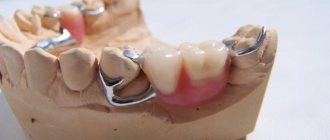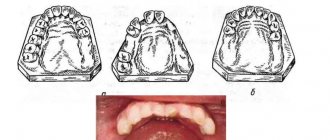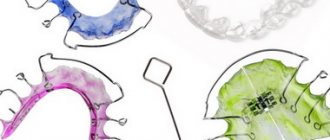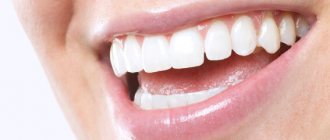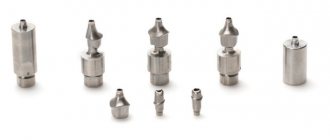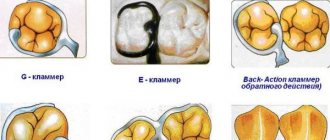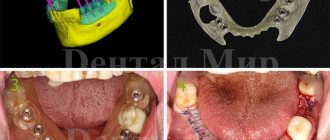Clasps or hooks on dentures: classification, what they are and how they are used
Article navigation
- What is it and what is it used for
- Classification
- Requirements
- Manufacturing
- Common clasp designs
- How to remove dentures
- Complications
- Alternatives
- Price
Question for a specialist
To fix removable dentures, dentists use various fasteners. One of the most common types is clasps or the most common hooks. Next, we will tell you in more detail about the types of clasps in orthopedic dentistry, about their purpose and structure, what functions they perform, and what requirements must be met when using them.
Dentoalveolar clasp
Plastic is used to make a dentoalveolar clasp. This type of fastener is indicated for anterior teeth. To make it more reliable, the plastic is reinforced with wire. Although this makes the structure stronger, the quality of the material deteriorates. How much dentures cost is directly influenced by the type of design and material of manufacture.
The disadvantages of a dentoalveolar clasp include the fact that it causes the lip to protrude forward. It must not be used for supports with a low crown and alveolar process. Reuse of records is not permitted.
What is it and what is it used for
What is a clasp in dentistry? In German, klammer is a clamp, frame, bracket. In dentures, a clasp for removable dentures is an element of a partial denture, with the help of which the structure is attached to the abutment tooth and held on it. The simplest clasp looks like a small hook (that’s why such dentures are called “hooked”), but there are elements of more complex shapes. They are designed to fix and stabilize the prosthetic base - that is, the orthopedic structure must remain stable both at rest and during talking or chewing, during the process of swallowing food.
What does a clasp consist of? The design includes the following parts or elements - shoulders or rings, body and process, and in some cases the occlusal pad. Let's take a closer look at the structure of its components:
- shoulders or shoulder: this is an elastic part that covers the supporting tooth on the sides of the crown (instead of a shoulder there may be a ring) and is pressed against its gingival part, the shoulder itself smoothly passes into the body,
- the body is the connecting element between the shoulder and the process,
- the process is immersed in an acrylic base or attached to the arch of a clasp prosthesis,
- The occlusal pad is located on the chewing part of the crown between the tubercles of molars and premolars: it is a supporting element that helps to correctly distribute the chewing load. The pad is smoothly connected to the body,
- frontal overlay: the purpose is the same as the occlusal overlay, but it is placed on the front teeth (usually on the lingual side of the row, so as to be invisible from the side).
In turn, the shoulder is also divided into elements - the supporting and holding parts. The supporting one makes up approximately 70% of the length of the entire shoulder, and the holding one makes up the remaining 30%. The thickness of the clasp is on average 0.25-0.5 mm.
Clasps and boundary line
The choice of clasp for prosthetics directly depends on the position of the boundary line, for which there are five options:
- Location from the contact point in the defect area to the middle part of the proximal surface of the adjacent unit. In such cases, the use of Roach or Bonigrad models is recommended.
- The passage of the equator through the central part of the approximal region, with a smooth rise to the contact point of the adjacent element. Provides for the installation of an Acker support-retaining clasp.
- The diagonal position of the equator and the passage of an extended boundary line in the area of the defective chewing surface, with a tangential intersection of the supporting element and ending on the opposite side of the tooth neck. The preferred model is the Ney clasp.
- The high position of the equator, caused by increased abrasion of the enamel coating of the dentition. In such situations, the boundary line requires covering with artificial crowns, which allow restoring the natural anatomical shape.
- Low location of the boundary line in the presence of cone-shaped elements, with the equator located at the cervical level. Involves the use of supporting structures.
Types of clasps
Common models of retainers used in prosthetics include:
- A support-retaining clasp is a structure that combines two arms, a process and an occlusal lining, ensuring compliance with rigidity and thickness parameters that prevent fracture during operation. The prosthesis is fixed in the lower part, while the upper part, located above the center line, prevents the structure from moving. Similar models include Ney clasps, which do not require the installation of crowns during fixation, and are distinguished by their universal use for any condition of tooth enamel.
- Roach's clasp is a rod-type system with elongated arms that provide a springing effect and reduce the mechanical load on the dentition. They are distinguished by their aesthetics, ease of use with shortened crowns, as well as the ability to carry out retention procedures in various supporting areas of the dentition;
- The Acker clasp is a simple and affordable option used when installing clasp dentures, requiring supporting elements. As a rule, it is fixed on molars, which are distinguished by their rigidity and strength of structure;
- The Bonville clasp is a model whose design provides for installation using two occlusal-fissure pads, which ensure stabilization of the replacement system in case of elimination of unilateral defects, as well as if it is necessary to preserve antagonistic elements.
Classification and varieties
There are many types of classification of clasps - by function, shape, material of manufacture, method of connection with the prosthetic base, location of contact, degree of crown coverage, manufacturing methods. Let's look at each classification group in more detail.
By purpose or function
- retaining clasps: used in orthodontics (occlusion correction) and orthopedics (dental prosthetics). They have only 1 function - holding the plate or removable denture on the supporting crowns. When chewing, the entire load goes to the prosthetic base and gums, which can rub, resulting in pain and stomatitis. Another method of application is fixation of rubber dam (latex film for dental treatment),
- supporting-retaining (with an occlusal pad, for example): also options are also used in orthodontic and orthopedic treatment. However, they have 2 functions - holding and support. When chewing, the load will be distributed, among other things, to the supporting teeth, their ligaments and the adjacent bone (periodontal tissue). In this case, the mucous membranes “suffer” less.
Experts note that the division into retaining and support-retaining is conditional. Because retaining hooks also transfer part of the load to the periodontium. But in this case, the distribution of pressure is incorrect, so negative consequences often appear - injuries, loosening of teeth, loss of gums.
By shape
The following types of clasps are distinguished by shape:
- flat,
- tape,
- semicircular,
- round.
Don't know what type of prosthetics to choose?
We will help in the selection, advise where to read more information and compare types of prosthetics.
Consultation with an orthopedic doctor in Moscow clinics is free! Call now or request a call
Working hours: from 9:00 to 21:00 - seven days a week
According to the method of connection with the prosthesis base
The connection can be of the following types:
- stable, i.e. rigid: the hook, through which pressure is distributed on the crown, is fixedly attached to the prosthetic base. There is almost no load on the gums and alveolar ridge,
- springy or semi-labile: a distinctive feature is the presence of a long body that is capable of springing. Here, only part of the chewing load is applied to the crown, and the rest is absorbed due to the “lever effect”,
- articular or labile: due to the presence of a hinge (or joint), almost all the pressure from the prosthesis goes not to the support, but to the gum and alveolar ridge.
At the location of contact
Based on their location or location, these elements are divided into types such as:
- dental: adjacent to the crowns, most often made of metal,
- pelota or gingival: they are wide extensions of an acrylic base, fixed only on the gums,
- dentogingival: simultaneously in contact with the gums and supporting crowns. For example, immediate dentures or “butterflies” have these – what the clasps on a denture look like is shown in the photo.
According to the degree of coverage of dental crowns
- one-armed and two-armed,
- ring-shaped (also called “changeover”),
- double,
- multi-link clasp: is a frontal overlay (it was discussed at the beginning of the article) on the lingual surface of the front teeth - most often placed on the lower ones. Externally, a multi-link one looks like either a horizontal plate with processes or several united half rings. Helps stabilize an entire group of teeth.
According to the material of manufacture
Classification according to materials of manufacture includes such types of clasps as:
- from base metals: for example, from medical steel, nickel, cobalt alloys with chromium and iron, titanium alloys,
- from noble metals: platinum, gold, palladium,
- from synthetic polymers, resins: plastic, acrylic, nylon, acetal.
By manufacturing method
- bent clasps: for production, wire is used, which is bent in accordance with individual bite parameters. Such elements are more elastic or resilient, but fit less accurately to the crowns,
- cast: the manufacturing technique of casting also involves the use of metal. Cast metal clasps are less elastic, but more accurately replicate the anatomical parameters of the crown, i.e. fit tighter
- made using cold or hot polymerization: gingival ones are made from a synthetic polymer (acrylic, nylon, etc.), usually simultaneously with the manufacture of the prosthetic base.
Manufacturing
Clasps for dentures are made by stamping, casting, and also using forceps and special wire. Plastic clasps are mainly made using the casting method. Stamped varieties are made from metal alloys. Using special wire tongs, bent-cast types are made. Since the hook consists of a process, a shoulder and a body, for this you will need to make 3 bends. To make a shoulder, bend the end of the cast wire, then make a bend and form the body of the clasp.
The support-retaining type of fixator, in addition to the shoulder and body, also consists of an occlusal pad and an anchor part. The lining is located in the intertubercular groove. When the tubercles are very pronounced, it keeps the tooth from moving in the event of an angular force acting on it. An anchor is used to connect the structure to the metal frame.
Requirements for hook placement
Denture clasps must be selected in accordance with all of the following requirements:
- the fixation will be the same on all supporting teeth,
- rotation or overturning of the prosthesis is excluded,
- do not overestimate the bite in the presence of occlusal pads,
- do not lead to injury to the teeth (including those of the opposite or antagonistic teeth) when closing the jaws and chewing,
- do not greatly reduce the aesthetics of a smile: metal ones located in the “smile zone” are highly noticeable from the outside, while synthetic ones are less noticeable. But the latter quickly stretch and break more often,
- the supporting teeth do not have pathological mobility,
- crowns of correct anatomical shape and sufficient height (5 mm or more).
You also need to take into account the position of the boundary line - this is the line that divides the crown into supporting and retaining parts. This parameter is determined using a parallelometer device. So, for example, on the lower teeth, the upper part of the clasp (occlusal pad and top of the shoulder) is located above the boundary line, and the lower part of the shoulder falls below the line. On the upper jaw, everything is, accordingly, the opposite.
Overview of modifications
Common models of retainers used in prosthetics include:
- A support-retaining clasp is a structure that combines two arms, a process and an occlusal lining, ensuring compliance with rigidity and thickness parameters that prevent fracture during operation. The prosthesis is fixed in the lower part, while the upper part, located above the center line, prevents the structure from moving. Similar models include Ney clasps, which do not require the installation of crowns during fixation, and are distinguished by their universal use for any condition of tooth enamel.
- Roach's clasp is a rod-type system with elongated arms that provide a springing effect and reduce the mechanical load on the dentition. They are distinguished by their aesthetics, ease of use with shortened crowns, as well as the ability to carry out retention procedures in various supporting areas of the dentition;
- The Acker model is a simple and affordable option used when installing clasp dentures, requiring supporting elements. As a rule, it is fixed on molars, which are distinguished by their rigidity and strength of structure;
The Bonville clasp is a model whose design provides for installation using two occlusal-fissure pads, which ensure stabilization of the replacement system in case of elimination of unilateral defects, as well as if it is necessary to preserve antagonistic elements.
How is production carried out?
Manufacturing is carried out in a dental laboratory by a dental technician. First, the model of the prosthesis and materials are determined. As a rule, both metal wire and cast hooks are bent using special pliers, pliers and round nose pliers. Then the clasp is included in the base and the entire structure is tried on the patient; if necessary, the product is modified. During the manufacturing process, it is important to comply with the requirements for the manufacture of the shoulder and the implementation of the contact process. Thus, the shoulder should not overload the supporting tooth, but should adhere to the crown at the maximum number of points. The metal is well polished so that the hook does not injure the enamel and does not become a place where plaque accumulates. As for the process, it is bent with round nose pliers and notches are made for better connection with the base.
Basics of making a clasp
Clasps are made by technologists who focus on the prosthesis that will be installed on the patient. The manufacturing technology goes through the following sequence of actions:
- the clasp is essentially a hook that secures the prosthesis, so it is given the desired shape using specialized forceps, round nose pliers or pliers;
- first, a shoulder is formed that covers the dental crown;
- then the body itself is formed.
Dental technicians make the necessary bends to form clasps quickly and accurately, in just a few bends.
Common clasp designs
- Ney's system: there are 5 types of clasps - Acker, Roach, combined (from Acker and Roach designs), single-arm reverse action, single-arm ring. This system was developed in 1949 with the participation of dentists and engineers. It includes both already known fastenings (modified) and new ones,
- developed by Acker: a supporting-retaining element with a rigid connection, consisting of 2 arms, an occlusal pad and a body. One of the oldest and most famous varieties, which first appeared in 1926,
- Roach: a support-retaining device with an occlusal pad and a spring (elastic) connection, which is easy to distinguish from others - its two arms look like the letter “T”. Because of this similarity, the hook is called “split”. Made from cobalt-chromium and gold-platinum alloys,
- Bonneville: Also known as the “six-arm” because it consists of 4 arms and 2 occlusal pads. Fixes 2 teeth at once,
- Jackson: includes 2 branches and 2 bodies, made of wire,
- Adams: one of the most versatile and effective types, suitable for both free-standing teeth and those included in segments,
- arrow-shaped Schwartz clasp: consists of 1 or 2 links, can also be multi-link. It is made of elastic wire and fits well into the interdental spaces.
%akc72%
Clasp functions
The main purpose of clasp-type retainers is retention - holding the prosthesis in place during use. The clamps are a support that does not allow the structure to move in the direction of the mucosa; they counteract the force of lateral pressure and, to a small extent, the load along the vertical axis.
The shoulders contribute to the clamping of the support unit. Together, these functions ensure reliable fastening of the denture, which minimizes inconvenience during use and improves the quality of life.
Ney system
The methods were introduced into orthodontics by Ney in the middle of the last century. These are classic support-retaining clamps. They contain a process, two shoulder elements and an occlusal type overlay.
To minimize fastener fracture, the areas located closer to the base were made thicker and stronger, while the distant sections gradually became thinner, and the product took on the shape of a horn.
Ney devices include the following options:
- Single-armed.
- Forked Roach.
- Acker with two shoulders.
- Ring single-arm.
- Combined.
General characteristics include practicality, wear resistance, and high aesthetics.
Acker's clasp
One of the most effective and affordable fasteners. Installed on molars in the absence of one or more chewing elements and intact supports. Simple in design, it reliably keeps clasp dentures from moving.
The rigidity of the model’s frame can be considered both a plus and a relative minus, depending on the situation.
Various types of clasps
Complications that may arise due to clasps
Negative consequences or complications associated with prosthesis attachments can occur for various reasons. These include low-quality materials, errors at the manufacturing or installation stage, and non-compliance with operating rules. You may also be allergic to metal or synthetic materials. In patients who already have dentures made of other metals in their mouths, galvanosis often occurs - the sensation of an electrical impulse. Often chips and cracks appear in the enamel, gums bleed and recede, and the necks of the teeth are exposed.
If oral hygiene is unsatisfactory, pieces of food become trapped under the hooks, plaque and tartar form. This provokes caries, periodontitis, causes an unpleasant odor and generally worsens the aesthetics of a smile.
What alternatives exist
An alternative to clasp fixation are attachments (clasps) and telescopic crowns. All of these options are used for removable dentures. Dentists note that orthopedic structures on attachments are fixed better, and they themselves are completely invisible from the outside. As for telescopic crowns, this is also a very good option, but it is considered the most difficult to manufacture.
“Mom wore a clasp denture for several years. It seemed convenient, but outwardly the metal hooks on the teeth stood out. Well, she began to smile less, of course, because of this. Then the prosthesis had to be changed, and the doctor persuaded me to use attachments. “He turned out to be much better in beauty, from the outside he looks like his own teeth and no hooks are visible.”
Lina O., review from the website stomatology.rf
If we consider the best option for prosthetics in principle, then here the first place is firmly held by dentures fixed on implants - fixed or conditionally removable. They have many advantages - strong, reliable and durable fastening, highest aesthetics, comfort when chewing (they feel like your “native” teeth).
Read on the topic: conditionally removable dentures on implants - how they are attached and how they differ from others.
Clasp dentures
A clasp denture with clasps is a product with a metal frame. An acrylic or nylon base and artificial teeth are fixed to it. This type of prosthetics in the absence of several teeth is considered one of the most popular.
The advantages of a clasp denture with clasps include:
- compared to plate ones - small in size;
- no negative impact on taste perception, diction and tongue movement;
- long service life – 5 years;
- slow gum atrophy.
The clasp denture on the lower jaw does not fall out when talking or chewing food. This became possible thanks to the presence of a splinting structure with hooks, which further strengthen the teeth with increased mobility.
One of the disadvantages is the low aesthetics, because the hooks are visible, especially if they are on the front teeth. Under their influence, supporting teeth may begin to collapse. Since the hooks rub the mucous membrane, it takes a long time to get used to the clasp denture on the lower jaw.
How much does prosthetics cost?
The cost of prostheses with hook fixation is the lowest in the segment. For example, a “butterfly” prosthesis can cost from 6,500 rubles, a removable acrylic one from 15 thousand rubles. Much here depends on the length of the orthopedic structure, the type and material of the fastening, the number of clasps, and the base material.
1Glen P. McGeevey Partial Dentures, 2006.
Your questions and answers
QUESTION Hello, tell me, which prosthesis with clasps is better to install? Irina T.
ANSWER Hello, Irina. The choice of prosthesis will depend on the condition and number of supporting teeth, as well as the capabilities of the clinic and the patient’s preferences. With clasps you can make a removable partial denture, acrylic, Acry-free, nylon, acetal, or clasp denture. Better reliability and more compact sizes are found in classic clasp frames, as well as in their modern metal-free counterparts Quattro Ti (“Quadrotti”).
Author: Chernov A. R. (Thank you for your help in writing the article and the information provided)
